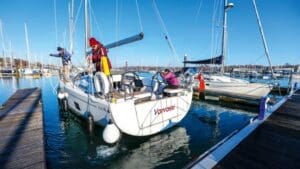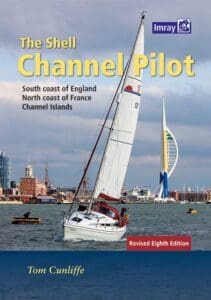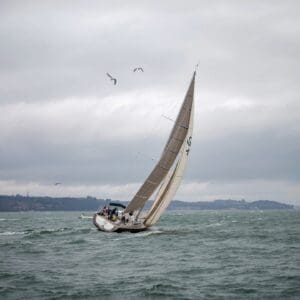Why Short Hops Matter
Not every sail has to be an epic offshore adventure. For many of us, the joy of sailing lies in short coastal hops: a Solent weekend from Hamble to Yarmouth, a night at anchor in Newtown Creek, or a relaxed reach east toward Chichester Harbour. These 1–2 day passages are the perfect classroom for crew to sharpen skills, build confidence, and, for the ambitious, make the jump into racing. As a late starter myself, I’ve discovered that mastering these shorter trips is the foundation of becoming a reliable and valued crew member. Here’s some of my thoughts on how to make every mile count.
The Essentials from Reeds Crew Handbook
I was asked to review Bill Johnson’s Reeds Crew Handbook recently (coming soon-Ed) and it has quickly become my go-to reference. The sections I have found most relevant to Solent sailing — and to crew keen to shine — include:
- Sail Handling: Clear diagrams of jib trim and reefing make sense of fluttering luffs, tell-tales and timing. The mantra “reef early” is especially vital in Solent gusts.
- Berthing & Anchoring: Johnson shows how fender height, spring lines, and calm signals can transform the “pontoon ballet” from chaos into choreography.
- Emergencies: His explanation of the crew’s role in a man-overboard drill — eyes on the casualty at all times — is drilled into my memory.
These lessons aren’t abstract. They’re the very skills that turn a weekend hop into a confident passage.
Two-Day Coastal Passage Planning
Short passages in the Solent still require thoughtful planning. Tides, ferry routes, and crowded harbours can catch out even experienced sailors.
Step One: Choose Departure Windows Wisely
For westbound trips, aim to leave on the last of the ebb so the flood carries you into Yarmouth or Lymington. Eastbound toward Chichester, ride the ebb past Cowes and aim to arrive before Chichester Bar turns lumpy with wind against tide.
Step Two: Identify Stopping Points
- Day 1 options: Hamble → Cowes → Newtown Creek (sheltered anchorage).
- Day 2 options: Cowes → Chichester Harbour → Bembridge.
Having bolt-holes marked on the chart is crucial. A forecast squall may make a snug night in Lymington preferable to a rolly anchorage.
Step Three: Build in Flexibility
Weather fronts shift faster in autumn. Add 20% contingency time and know where you could tuck in if progress slows.
Crew Roles & Communication Under Pressure
A 30–50 ft yacht is a team sport, and the smoother the communication, the smoother the sail. Here are the key roles:
- Bow Crew: Rig fenders, handle mooring lines, and manage the anchor.
- Pit Crew: Control halyards and reefing lines at the mast.
- Trimmers: Adjust sails for efficiency — small tweaks add big speed.
- Helm: Steers, but also coordinates manoeuvres.
- Lookout: Watches for traffic, pots, and channel marks — everyone should share this responsibility.
Sample Communication Script:
- Helm: “Ready to tack?”
- Trimmers/Bow: “Ready.”
- Helm: “Tacking… lee-ho!”
- Trimmers ease one sheet, grind the other; bow crew check the lazy sheet is clear.
The trick is to keep phrases short, calm, and repeated back. In a busy Solent marina, clear comms can mean the difference between a smooth docking and a public fender-bender.
From Coastal Cruise to Race Hatch
Many Solent sailors dip into racing, from Wednesday night beer-can races to Cowes Week. The jump from cruising to racing is less about bravery and more about preparation.
- Mental Preparation: Racing is about focus and rhythm. Even as crew, expect to be on task from the five-minute gun until the finish.
- Physical Preparation: Practice hoists and drops at anchor before race day. Know your role: pit, bow, or trimmer. Muscle memory beats confusion when 20 boats converge on the same mark.
- Reef Early, Reef Fast: It’s tempting to carry too much sail for speed. But a well-timed reef often wins races by keeping the boat balanced and the crew safe.
- Post-Race Debrief: The best crews spend ten minutes afterwards reviewing what worked, what didn’t, and who owes the first round ashore.
Final Thoughts: Mastery Through Miles
Mastering coastal hops in the Solent isn’t about racking up miles for the logbook. It’s about learning the rhythm of tides, anticipating the skipper’s needs, and becoming the kind of crew that skippers trust — and invite back.
As autumn approaches and racing calendars fill, these lessons make the difference between being just another pair of hands and being a crew member who adds real value.
So whether you’re setting off for Newtown Creek, timing your exit through Hurst Narrows, or trimming a headsail in a club race, remember: short hops are the training ground. Get them right, and you’ll be ready for anything.
Mike


